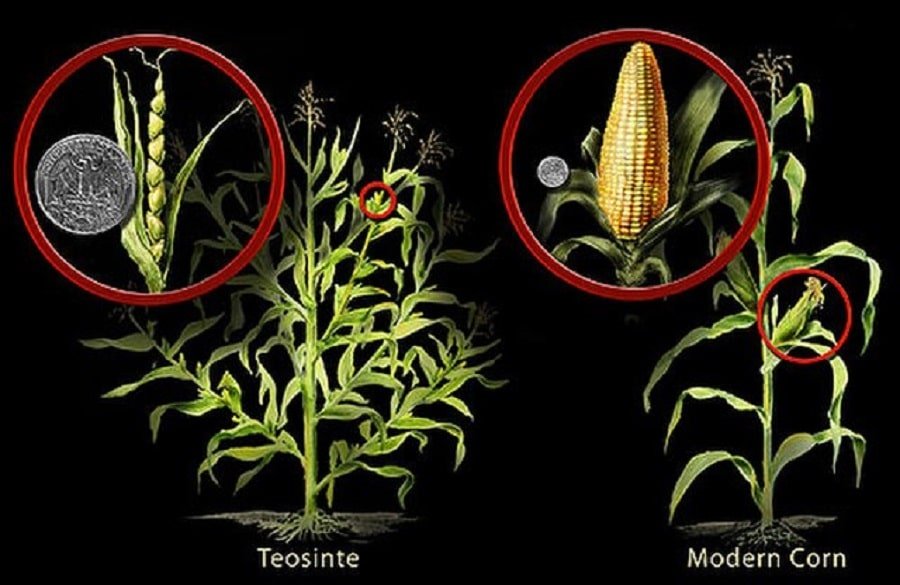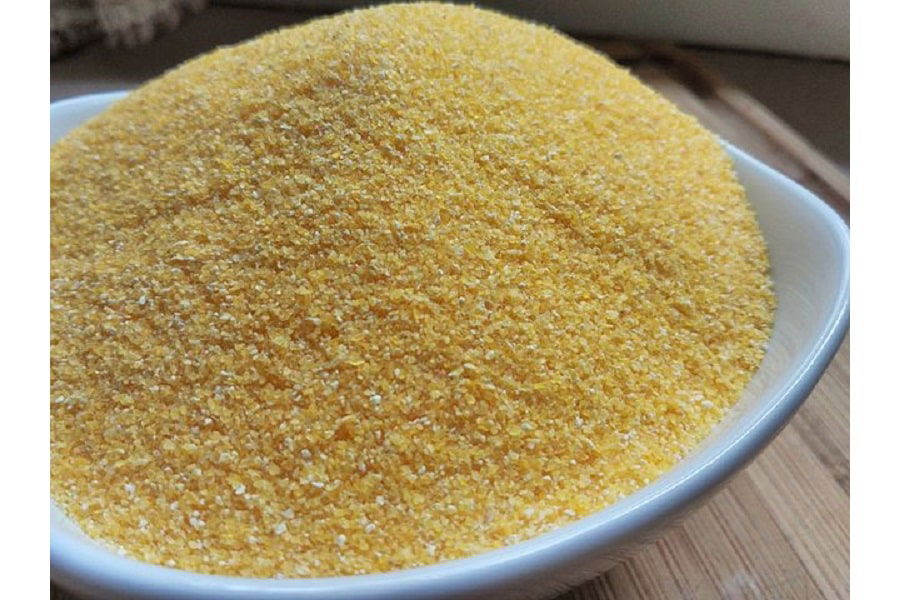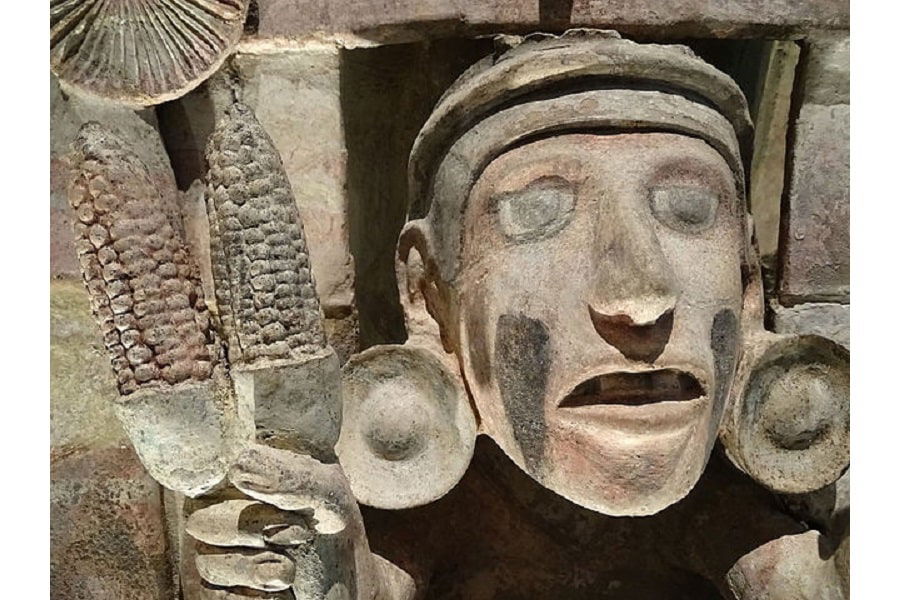The origin of corn can be traced back to ancient Mesoamerica, specifically to an area that includes present-day Mexico and Central America. Corn, also known as maize and Zea mays was domesticated by indigenous peoples in this region thousands of years ago and has a rich history as a staple crop that has deeply influenced societies worldwide.
Native American civilizations recognized its nutritional value, incorporating it into their diets and cultural practices. It was eventually introduced to other parts of the world through European exploration and colonization. It spread to Europe, Africa, and Asia, where it became an important crop in many regions. Today, corn is one of the most widely grown and consumed cereal crops worldwide.
Table of Contents
What is the Origin of Corn? Teosinte and Corn’s Indigenous Roots in North America

Corn has deep indigenous roots in North America. Teosinte, a wild grass native to Mesoamerica, is considered the ancestor of modern corn [2]. It differs significantly from corn in appearance, with small ears and a tough outer covering. Teosinte grows naturally in parts of Mexico and Central America, and it was through the observant eyes of ancient farmers that its potential for cultivation was recognized [3].
Domestication of Teosinte: The Transformation into Corn
The domestication of teosinte marked a turning point in the history of corn. Through generations of selective breeding, ancient farmers gradually transformed teosinte into the corn we know today. They carefully selected plants with desirable traits such as larger and sweeter kernels, gradually improving taste, texture, and yield [5].
The domestication process involved selecting plants that exhibited beneficial traits and crossbreeding them to reinforce those traits in subsequent generations. Over time, the characteristics of teosinte began to change, leading to the development of different varieties of corn with diverse shapes, sizes, and colors [5].

When Was Corn Introduced to Europe?
The journey of corn from its indigenous roots in North America to Europe marked a significant turning point in the global spread of agriculture [3].
The introduction of corn to Europe can be traced back to the late 15th century when Christopher Columbus encountered corn during his voyages to the Americas. It is believed that Columbus first came across corn in the Caribbean islands, and from there, its cultivation and distribution quickly spread throughout Europe [1].
READ MORE: Who Discovered America: The First People Who Reached the Americas
By the early 16th century, corn had made its way to the Iberian Peninsula, specifically Spain and Portugal. The warm climates of these regions were conducive to corn cultivation, and it gained popularity as a valuable food source. From there, corn cultivation expanded to other parts of Europe, including Italy, France, and the British Isles [4].
Impact of Corn on European Agriculture and Cuisine
The introduction of corn had a profound impact on European agriculture and cuisine. Corn proved to be a versatile crop that could thrive in diverse environments, making it a valuable addition to European agricultural practices. Its adaptability allowed for increased crop diversity and reduced dependence on traditional grains like wheat and barley [5].
Corn’s high productivity and ability to grow in less fertile soils provided European farmers with a reliable source of food and feed for livestock. It played a crucial role in alleviating food shortages and contributed to the stability of European agricultural systems. The introduction of corn also brought about advancements in farming techniques and technologies, as farmers sought to optimize corn yields and cultivation methods [1].
In terms of cuisine, corn quickly became a staple ingredient in European dishes [3]. It was used in various culinary preparations, including bread, porridge, stews, and even alcoholic beverages such as whiskey. Cornmeal, made from ground corn, became a common ingredient in European cooking, offering a new dimension of flavor and texture to traditional recipes [6].
READ MORE: The Birth of Booze: Who Invented Alcohol and How It Shaped History?
The impact of corn on European agriculture and cuisine was not limited to its immediate introduction. Over time, corn cultivation expanded across the continent, with different regions adopting specific corn varieties and incorporating them into their local food cultures [4]. Corn became deeply ingrained in European culinary traditions, enriching the gastronomic landscape with its unique flavors and nutritional contributions.

What Did Corn Used to Look Like? Evolution of Corn’s Appearance
The original appearance of corn, derived from teosinte, differed significantly from the corn we are familiar with today. Teosinte had small ears with only a few rows of kernels and a tough outer covering. Its kernels were hard and encased in a dense husk, making them less palatable compared to modern corn [6].
Despite these differences, early farmers recognized the potential of teosinte and its nutritional value. Through careful selection and cultivation, they began to notice variations in corn plants, particularly those with larger and sweeter kernels. These early corn varieties started to exhibit traits that were more desirable for human consumption [3].
How Selective Breeding Transformed Its Appearance Over Time?
Selective breeding played a crucial role in transforming the appearance of corn over time. Early farmers selectively bred corn plants with desired traits, such as larger kernels, improved taste, and higher yield. By saving and replanting seeds from the best-performing plants, they gradually altered the genetic makeup of corn, resulting in significant changes in its appearance [3].
Over generations of selective breeding, corn underwent remarkable transformations. The size of the ears increased, with more rows of kernels tightly arranged on the cob. The kernels themselves became larger, plumper, and more succulent [1]. The tough husks gradually became thinner and easier to remove, making the kernels more accessible for consumption.
Selective breeding also led to the development of various corn varieties with distinct colors, shapes, and textures. From the classic yellow and white kernels to the vibrant hues of blue, red, and purple, corn exhibits a wide spectrum of colors that add visual appeal to culinary preparations [2].
Furthermore, selective breeding allowed for the cultivation of corn with specific characteristics suited to different purposes. Some varieties were bred for their sweetness, making them ideal for fresh consumption or as ingredients in desserts. Others were bred for their sturdiness and suitability for processing into cornmeal, corn flour, or other food products [2].

Discovery of Corn
The discovery of corn holds immense historical and cultural significance, particularly in the context of Native American civilizations.
The Significance of Corn in Native American Civilizations
Corn held immense significance in the lives of Native American civilizations. It was more than just a food source, it had deep cultural, spiritual, and symbolic meaning. Corn was associated with fertility, abundance, and the cycle of life. It was often woven into religious rituals, ceremonies, and mythologies, reflecting its essential role in the culture and worldview of indigenous peoples [7].
Corn festivals and harvest ceremonies celebrated the planting, growth, and harvest of corn, emphasizing its importance in community life. These festivities provided an opportunity for communities to express gratitude to the Earth for its bountiful gifts and to reinforce social bonds [6].
Spread of Corn Cultivation among Indigenous Cultures
The cultivation of corn gradually spread among indigenous cultures throughout North America. As different cultures interacted and exchanged knowledge, corn cultivation techniques and varieties spread geographically [1]. Native American tribes who encountered corn through trade or migration adopted its cultivation, adapting it to their local environments.
The spread of corn cultivation allowed diverse indigenous cultures to harness the benefits of this versatile crop [4]. From the northern reaches of present-day Canada to the southern regions of South America, corn became a staple crop in various communities, supporting their sustenance and contributing to the development of their unique agricultural practices [1].
Historical Context and Early Cultivation of Corn by Native American Civilizations

The historical context of corn’s discovery and early cultivation is closely intertwined with the rise of advanced civilizations in the Americas. Native American cultures, such as the Mayans, Aztecs, and Incas, cultivated corn as a staple crop, forming the foundation of their agricultural practices [1].
READ MORE: The Aztec Empire: The Rapid Rise and Fall of the Mexica
The Mayans, an ancient Mesoamerican civilization, were pioneers in corn cultivation. They developed sophisticated agricultural techniques, including the construction of terraced fields and the use of irrigation systems, to maximize corn production [1]. Mayans recognized the importance of corn in their society, and it held deep religious and symbolic significance for them. They believed that humans were created from corn, and corn deities played a central role in their mythology and rituals [3].
READ MORE: How Long Have Humans Existed?
The Aztecs, another influential civilization in Mesoamerica, relied heavily on corn as a dietary staple. They cultivated various varieties of corn and incorporated them into their diverse cuisine. Corn was used to make tortillas, tamales, and beverages such as atole [6]. The Aztecs also introduced the concept of nixtamalization, a process that involved soaking corn in an alkaline solution to make it more nutritious and easier to process. Corn was a vital part of Aztec culture, and they even had a goddess named Chicomecoatl, who was associated with corn and fertility[4].
READ MORE: The 23 Most Important Aztec Gods and Goddesses
In the Andean region of South America, the Incas embraced corn as a critical crop. They developed sophisticated agricultural systems, such as terracing and the construction of agricultural terraces known as “andenes,” to cultivate corn in the challenging mountainous terrain [6]. Corn played a central role in Inca society, and they held elaborate ceremonies to honor the corn harvest. The Incas also practiced selective breeding to develop corn varieties adapted to different altitudes and climates [7].
These ancient civilizations not only cultivated corn for sustenance but also used it as a form of currency and trade. Corn was a valuable commodity that facilitated economic exchange within and between these civilizations [4]. It played a crucial role in the development and prosperity of their societies, providing a stable food source and supporting population growth.
The cultivation of corn by these civilizations dates back thousands of years. Archaeological evidence reveals that corn was being cultivated in the Americas as early as 5,000 to 6,000 years ago [3]. Native American farmers developed sophisticated agricultural techniques, including irrigation systems and terraced farming, to support the growth of corn and other crops [3].

The Role of Native Americans in Spreading Corn Cultivation
Native Americans played a crucial role in spreading corn cultivation across different regions of the Americas. Through trade networks, cultural exchange, and migration, the knowledge and cultivation techniques of corn were shared among various Native American tribes and civilizations [3].
The spread of corn cultivation by Native Americans was a dynamic and ongoing process. As different tribes adopted corn into their agricultural practices, they also adapted it to suit their local climates and environments, leading to the development of distinct regional corn varieties. This diverse cultivation of corn by Native American cultures contributed to the richness and variety of corn found across the Americas [7].
References
- Smith, C. W. (2004). Corn: Origin, History, Technology, and Production.
- Doebley, J., & Goodman, B. A. (2003). Teosinte to Maize: The Biology of Zea mays.
- Fussell, B. (2004). The Story of Corn.
- Warman, A. (2003). Corn and Capitalism: How a Botanical Bastard Grew to Global Dominance.
- Harris, D. R. (2010). Origins of Agriculture in Western Central Asia: An Environmental-Archaeological Study.
- National Research Council. (1989). Lost Crops of the Incas: Little-Known Plants of the Andes with Promise for Worldwide Cultivation.
- Weatherwax, P. (1954). Indian Corn in Old America